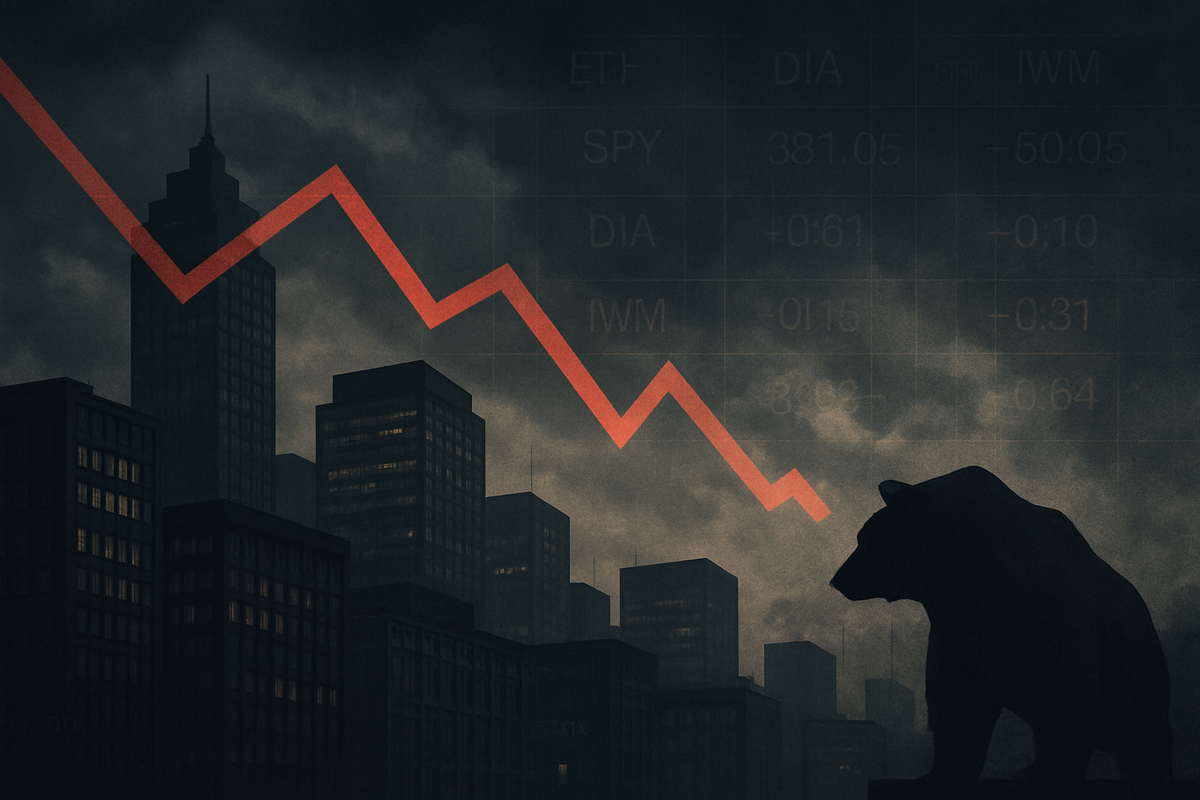
A significant surge in capital flowing into short-bias Exchange-Traded Funds (ETFs) has sent a clear signal through the financial markets: investor sentiment is shifting towards caution and a potential stock market pullback. This notable trend, particularly pronounced in recent weeks, suggests that a growing number of investors are actively positioning themselves to profit from or hedge against anticipated market declines, raising questions about the sustainability of current market valuations.
These substantial inflows reflect a palpable unease among market participants, who appear to be preparing for potential turbulence after a period of robust gains. The movement of billions into funds designed to thrive on market downturns underscores a growing belief that the bull run, particularly in high-flying sectors, may be nearing a correction.
The Bearish Bet: A Closer Look at Recent Inflows
The past month has witnessed a dramatic increase in investor allocation to short-bias ETFs, marking one of the most significant shifts in sentiment in years. Global short-bias funds experienced a staggering $3.7 billion in inflows during September 2025, representing the largest monthly influx in nearly three years. This trend has not abated, with an additional $1.4 billion pouring into these funds in the early days of October, specifically leading up to the current date of October 9, 2025.
U.S.-focused funds have captured a substantial portion of this capital, attracting $2.2 billion in September alone. However, the bearish sentiment is not confined to American shores; Japanese and South Korean funds also saw considerable investment, drawing $653 million and $424 million, respectively. These inflows are targeting funds that are designed to bet against major stock indexes like the S&P 500 and Nasdaq, as well as specific fast-rising sectors, most notably technology and artificial intelligence (AI). Prominent examples of funds that have seen significant cash infusions include the Direxion Daily Semiconductor Bear 3X (NYSEARCA: SOXS) and various ProShares' short Nasdaq (NASDAQ: PSQ) and S&P 500 (NYSEARCA: SH) products.
This timeline of events, culminating in the current heavy inflows, follows a period of strong market performance, with the S&P 500 (NYSEARCA: SPY) up 15% and the Nasdaq Composite (NASDAQ: QQQ) up 19% year-to-date. However, this bullish run has been accompanied by rising concerns over stretched valuations. Key players and stakeholders involved in this shift include institutional investors, hedge funds, and increasingly, retail investors who are utilizing these accessible ETF vehicles to express their bearish views or manage portfolio risk. The initial market reaction has been one of heightened vigilance, with analysts closely monitoring these flows as a potential leading indicator of future market direction.
Detailed Coverage: A Tactical Response Amidst Prevailing Bullishness
Leading up to October 9, 2025, the broader Exchange Traded Fund (ETF) market had been experiencing record-breaking inflows, largely driven by strong investor confidence in U.S. equities, fixed income, and cryptocurrencies. This generally "risk-on" sentiment saw overall ETF inflows in 2024 and 2025 reaching unprecedented levels, with U.S.-listed ETFs gathering $1.12 trillion in 2024 and on pace to exceed that in 2025. These substantial flows were primarily directed toward long-only equity funds such as Vanguard S&P 500 ETF (NYSEARCA: VOO), iShares Core S&P 500 ETF (NYSEARCA: IVV), and Invesco QQQ Trust (NASDAQ: QQQ), alongside significant investments in spot Bitcoin and Ether ETFs.
However, interspersed within this bullish landscape were specific periods of market turbulence that spurred tactical, short-term inflows into short-bias ETFs. These funds, also known as inverse or bear ETFs, are engineered to deliver returns opposite to a specified index, sometimes with leverage (e.g., -1x, -2x, or -3x) for amplified inverse performance. They are typically employed for short-term trading or hedging against anticipated market declines due to their inherent complexities like compounding effects and tracking errors over longer holding periods.
Notable instances of increased short-bias ETF activity and inflows include a period of market turmoil in Q1 2025, driven by fears of an escalating trade war, geopolitical tensions, and potential inflation and recession. During this time, the S&P 500 experienced a 9% decline, and the Nasdaq and Russell 2000 entered bear market territory. Inverse ETFs such as the ProShares Short S&P 500 ETF (NYSEARCA: SH) and ProShares UltraPro Short QQQ (NASDAQ: SQQQ) saw increased activity and significant gains, with SQQQ surging over 30% for the week ending April 4, 2025. In May 2025, SQQQ alone recorded a "big inflow" of approximately $212.7 million in a single week. The Direxion Daily Semiconductor Bear 3x Shares (NYSEARCA: SOXS) has also shown consistent, though fluctuating, inflows throughout 2025, with a 1-year fund flow of $1.63 billion USD. Moreover, specific interest in targeted inverse products, such as "Huge TSLQ Inflows" (Tradr 2X Short TSLA Daily ETF, betting against Tesla (NASDAQ: TSLA)), was observed in April 2025.
Key players driving these flows include ETF issuers like ProShares and Direxion, who provide these specialized products. Institutional investors, including hedge funds and various advisory firms, have tactically added to or reduced stakes in inverse ETFs during periods of market stress. Day traders and sophisticated investors also utilize these instruments for short-term speculative or hedging strategies. The initial market reaction to these inflows has been characterized by heightened vigilance, though the overall industry narrative has largely remained focused on the massive inflows into long-only equity and fixed-income ETFs, suggesting these bearish bets are seen more as tactical responses to specific market uncertainties rather than a complete shift in broad market sentiment.
Companies on the Cusp: Winners and Losers in a Bearish Turn
A significant inflow into short-bias ETFs, coupled with a potential stock market pullback, indicates a bearish sentiment among some investors who aim to profit from declining market prices. This scenario would create distinct winners and losers among public companies, affecting various sectors differently.
Potential Losers: Companies and sectors most vulnerable often share characteristics such as high valuations, reliance on economic growth, high debt, or speculative business models.
- Technology and AI (High-Growth/Speculative Stocks): These sectors are frequently cited as overvalued, particularly firms with substantial valuation expansion based on future growth potential and limited current profitability. Companies like Nvidia (NASDAQ: NVDA), Microsoft (NASDAQ: MSFT), and Oracle (NYSE: ORCL), despite their significant gains driven by AI optimism, could face substantial selling pressure.
- Consumer Discretionary: This cyclical sector, encompassing retail, media, consumer services, and luxury goods, is highly sensitive to economic slowdowns. Reduced non-essential spending during a downturn directly impacts their revenue.
- Industrials: Also cyclical, industrial companies tend to decline during corrections linked to economic slowdowns or reduced business investment.
- Commercial Real Estate: Vulnerable due to higher interest rates increasing financing costs and a slowing economy potentially leading to higher vacancy rates.
- Highly Leveraged Companies: Firms with high debt loads or those heavily reliant on easy credit for expansion would be vulnerable as borrowing costs rise.
- Smaller, Less Established Companies: These often lack the financial resilience of larger counterparts.
Potential Winners (or those less affected): Certain "defensive" sectors and companies tend to be more resilient due to stable demand, strong balance sheets, or the ability to benefit from market shifts.
- Consumer Staples: Companies producing everyday essentials like Procter & Gamble (NYSE: PG), Coca-Cola (NYSE: KO), Walmart (NYSE: WMT), and Johnson & Johnson (NYSE: JNJ) tend to be stable as demand remains consistent.
- Utilities: Providers of essential services such as NextEra Energy (NYSE: NEE) and Edison International (NYSE: EIX) offer reliable revenue streams and stability.
- Healthcare: Demand for medical services, pharmaceuticals, and devices remains relatively stable regardless of economic conditions. Regeneron Pharmaceuticals (NASDAQ: REGN) and Pfizer (NYSE: PFE) are examples.
- Cybersecurity Providers: Essential services like those from CrowdStrike (NASDAQ: CRWD) are unlikely to see reduced spending even in a downturn.
- Companies with Strong Balance Sheets and Consistent Free Cash Flow: Financially robust companies are better positioned to weather volatility.
- Companies Offering Diversification or Unique Market Positions: Taiwan Semiconductor Manufacturing (NYSE: TSM) due to its critical role in tech, or MercadoLibre (NASDAQ: MELI) for its Latin American focus, could offer relative resilience.
For "losers," impacts would include stock price declines, increased scrutiny from short sellers, difficulty raising capital, and negative effects on employee morale. "Winners" would likely experience relative stock price stability, increased investor confidence as "safe havens," consistent dividend income, and potential for relative outperformance.
Wider Implications: A Bellwether for Broader Market Trends
The substantial inflows into short-bias ETFs are more than just a fleeting market phenomenon; they serve as a critical bellwether for broader industry trends and underline a significant shift in the prevailing financial narrative. This event fits squarely into a pattern of increasing investor skepticism regarding the sustainability of current equity valuations, especially after a prolonged period of growth fueled by technological advancements and, more recently, AI hype. The MSCI World index's forward 12-month price-to-earnings ratio standing near a five-year high at 20.4 at the end of September provides a stark backdrop for these bearish bets.
The potential ripple effects on competitors and partners are considerable. Short-bias ETFs offer an accessible alternative to traditional short-selling, potentially drawing capital from other investment vehicles. Authorized Participants (APs), crucial in ETF creation/redemption, engage in "operational shorting" which, while improving liquidity, can contribute to systemic risk. Brokers and custodians must manage increased volume and complexity. Regulatory bodies, such as the SEC, are increasing scrutiny on transparency and oversight, requiring detailed reporting of short positions and addressing concerns about "naked short-selling" and its impact on market stability. Investor protection is also a focus, ensuring that investors understand the complexities and risks of leveraged and inverse products.
Historically, the current inflows resonate with periods of market stress. Short-bias funds proved highly profitable during the 2008 financial crisis, reinforcing their appeal during perceived market vulnerability. The overall growth of ETFs since their inception has provided the vehicles for these sophisticated hedging strategies. However, the phenomenon of "hyper-inflows" into certain themes has historically led to subsequent underperformance, suggesting that an overly concentrated bearish sentiment could lead to crowded trades. Macroeconomic factors like interest rates and inflation also continue to influence these flows, drawing parallels to how emerging markets respond to global economic shifts.
What Comes Next: Navigating the Shifting Tides
Significant inflows into short-bias ETFs signal increased caution and a collective bet on an impending market pullback, carrying various short-term and long-term implications. In the short term, the market may experience heightened sensitivity and potential turbulence, leading to increased volatility and a rotation out of riskier assets, particularly in fast-growing sectors like semiconductors and big tech.
Over the long term, increased short interest can contribute to market health and efficiency. Short selling plays a crucial role in price discovery, preventing market bubbles by bringing overvalued stocks to more reasonable levels, thereby reducing the risk of sudden, severe corrections. This sustained pressure can lead to improved corporate governance and greater transparency.
Public companies, especially those targeted by short sellers, face considerable challenges, including legal, reputational, and governance stress tests. They may need to enhance transparency and communication, conducting swift and strategic responses to negative narratives. Operational and financial reviews become critical to address underlying issues, potentially leading to improved efficiency and financial health. Corporate governance reforms may be necessary to improve oversight and accountability. In extreme cases, sustained pressure could lead to strategic restructuring, including mergers, acquisitions, or even liquidation.
Market challenges include increased volatility, downward pressure on equity prices, and potential liquidity constraints for individual stocks. However, opportunities also emerge. Contrarian investors can identify and accumulate shares of quality companies that become temporarily undervalued. Investors can employ rotation strategies into less extended or overlooked sectors. The overall market benefits from enhanced efficiency and transparency. The increased caution may also drive interest in defensive investment strategies like outcome-oriented ETFs or those focused on quality and low volatility.
Potential scenarios range from a market correction aligning with bearish bets, to prolonged volatility without an immediate crash. A "short squeeze" could occur if the market defies bearish sentiment. Ultimately, the scrutiny driven by short sellers can lead to stronger, more transparent, and better-managed public companies. There could also be a broader shift in investment allocations towards safer assets or actively managed strategies.
Wrap-Up: Prudence in a Precarious Market
Recent months have witnessed a notable surge in inflows into short-bias Exchange Traded Funds (ETFs), signaling a growing unease among investors regarding elevated market valuations and the potential for a market pullback. These inflows, particularly significant in September and early October 2025, reflect a shift in investor sentiment amidst record highs in major equity indices.
Summary of Key Takeaways: Global short-bias funds attracted substantial inflows, with $3.7 billion in September 2025 and an additional $1.4 billion in early October. This indicates investors are increasingly positioning for a downturn, despite the S&P 500, Nasdaq, and Dow reaching fresh peaks, largely fueled by AI optimism. Funds like Direxion Daily Semiconductor Bear 3X (NYSEARCA: SOXS), ProShares UltraPro Short QQQ (NASDAQ: SQQQ), and ProShares Short S&P 500 (NYSEARCA: SH) have seen considerable capital. Historically, such inflows coincide with market stress, serving as tools for hedging or speculation.
Assessment of the Market Moving Forward: The significant inflows suggest growing caution and potential risk aversion. Financial leaders globally have voiced concerns about looming market corrections due to lofty valuations, with the MSCI World index's forward 12-month P/E ratio at a near 5-year high of 20.4. This creates a conflicting picture where some investors bet on continued growth while others actively hedge. The specific growth in short-bias ETF assets points to rising conviction in bearish outlooks within a segment of the investment community, even as overall equity markets have performed strongly year-to-date.
Final Thoughts on Significance and Lasting Impact: The surge in short-bias ETF inflows underscores palpable apprehension regarding the sustainability of the current bull market. It signifies a collective attempt by a segment of investors to protect existing gains or capitalize on anticipated market pullbacks. While not definitive predictors of a downturn, they are potent indicators of heightened investor unease and a growing focus on risk management. The lasting impact could be a more widespread adoption of inverse ETFs as tactical tools, though investors must understand their short-term design due to compounding risks and daily resets.
What Investors Should Watch For in Coming Months:
- Market Valuations and Corporate Earnings: Assess if fundamental performance justifies current market levels.
- Central Bank Policy and Economic Data: Monitor Federal Reserve communications on interest rates and macroeconomic data like inflation and employment.
- Geopolitical and Systemic Risks: Be aware of global political instability, trade relations, and potential systemic vulnerabilities.
- Continuation of ETF Flow Trends: Observe if short-bias ETF inflows accelerate or reverse, indicating deepening bearish sentiment or renewed confidence.
- Sectoral Performance: Monitor growth-oriented sectors, especially technology and AI, which are often targets for short-sellers.
- Volatility Indicators: Track indices like the VIX, as a rise often coincides with increasing market uncertainty.
- Underlying ETF Mechanics: Understand daily reset mechanisms, leverage, and specific benchmarks for those utilizing short-bias ETFs.
This content is intended for informational purposes only and is not financial advice.





